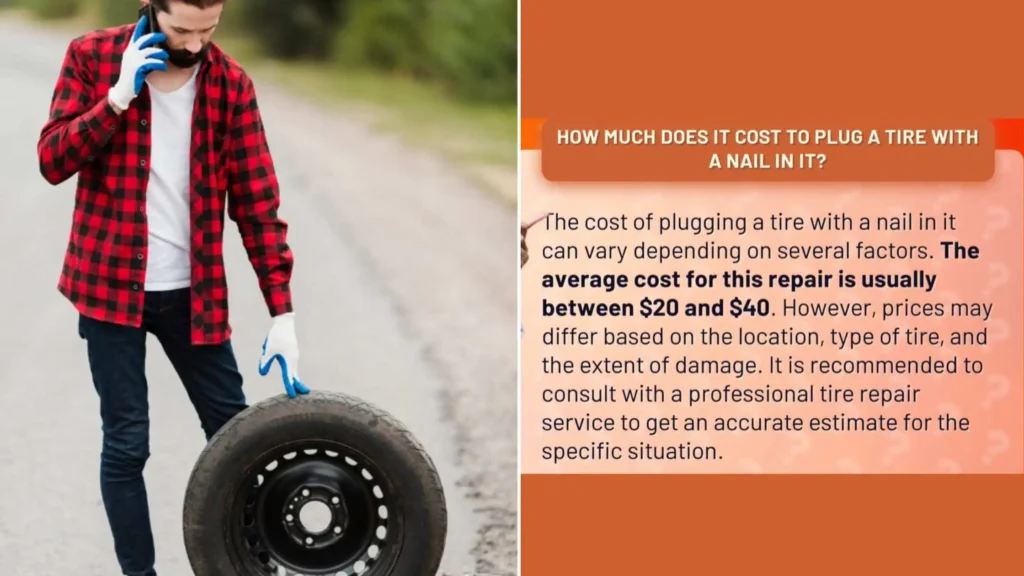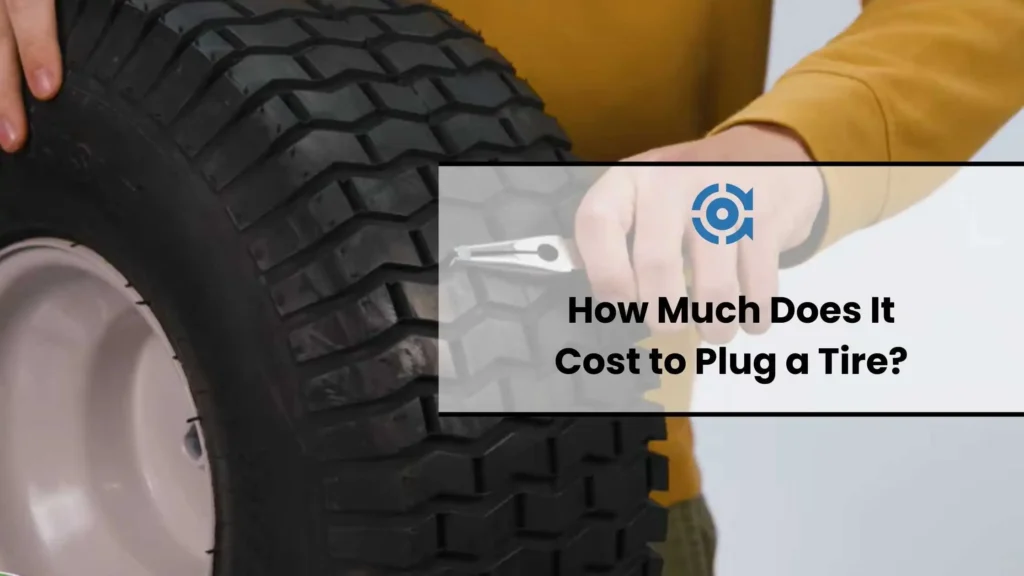In the U.S., a professional flat repair (the industry-standard patch-and-plug combo) typically ranges from $15 to $40 as of August 29, 2025, and some national chains perform this service at no charge; “plug-only” fixes are considered temporary.
Facing a flat tire can be an inconvenience, but a simple plug can often be the quick and affordable solution drivers seek. Tire plugging is a common repair method that can extend the life of your tire without needing a full replacement.
Many auto repair shops, tire shops, and even some larger gas stations offer this service, ensuring that you can get back on the road with minimal disruption. Remember to check your tire for any potential issues regularly, as catching punctures early can save both time and money. Make sure to consult with a professional to confirm that a plug is the appropriate repair for your tire’s condition. (In the U.S., current guidelines require the puncture to be repaired from the inside with a patch plus a stem/plug for a permanent fix.)
Introduction To Tire Repair Costs

Knowing the cost of plugging a tire is vital. It helps plan your budget. Costs vary widely. They depend on several factors. This guide will break down those factors. We’ll compare doing it yourself versus hiring a professional.
Factors Affecting Price
The cost to plug a tire can change. Here’s why:
- Type of Damage: Small punctures are cheaper to fix than big cuts.
- Tire Type: High-performance tires often cost more to repair.
- Location: Prices can be higher in big cities.
Diy Vs Professional Repair
Should you fix the tire yourself or get help? Let’s see:
| DIY Repair | Professional Repair | |
|---|---|---|
| Cost | Usually under $20 for a basic plug kit | (U.S.) Typically $15 to $40; some chains offer free flat repair |
| Tools Needed | Tire plug kit | None, the shop has everything |
| Time | Less than an hour | Depends on the shop’s queue |
| Skills | Some mechanical skills needed | No skills needed |
Plugging a tire yourself saves money. But, it needs some skill. Professional help costs more. Yet, it ensures the job is done right.
Understanding Tire Puncture
Tire punctures can be a driver’s worst nightmare, leading to unexpected expenses and safety concerns. Knowing the common causes and types of tire damage is crucial for maintaining your vehicle. Let’s dive into the intricacies of tire punctures and understand what often lies behind that sudden hiss of air.
Common Causes Of Punctures
- Sharp objects: Nails, glass, and debris are the usual suspects.
- Poor road conditions: Potholes and uneven surfaces may harm tires.
- Wear and tear: Over time, tires can weaken and become more prone to damage.
- Incorrect air pressure: Both over-inflation and under-inflation increase puncture risk.
- Valve stem issues: Damaged or aged valve stems can lead to air leaks.
Types Of Tire Damage
Not all tire damage is the same. Some punctures are simple to fix, while others mean a new tire is needed. Here’s a breakdown of tire damage types:
| Damage Type | Can it be plugged? |
|---|---|
| Tread punctures | Yes, usually |
| Sidewall damage | No, it’s unsafe |
| Bead leaks | No, needs professional bead reseal (not a plug) |
| Shoulder punctures | No, it’s unsafe |
Plugging a tire is often the go-to fix for tread punctures. It’s a quick and affordable solution. But, remember, not all damage can be plugged. For your safety, always get a professional’s opinion.
Price Range For Tire Plugging

Knowing the cost of plugging a tire is important for car owners. This cost can vary. Let’s dive into the price range for tire plugging.
Average Cost Across Different Regions
The cost of plugging a tire can change from one place to another. We have gathered average prices from various regions to help you understand what to expect. These are general estimates (as of August 2025) and reflect repairable tread punctures:
- North America (U.S.): $15 to $40 for professional patch-and-plug; some chains repair flats for free
- Europe: €25 to €35 typical at major chains (country and provider dependent)
- Asia (example—India): ₹200 to ₹400 for standard puncture repair in many urban shops
These prices are for a single tire and usually include both labor and materials.
Price Comparison: Plugging Vs Patching
People often choose between plugging and patching a tire. Both have different costs.
| Method | Cost |
|---|---|
| Plugging (DIY/temporary) | $5 to $15 (kit/consumables) |
| Patching (with internal repair; often done with plug) | $15 to $40 (U.S. professional) |
Plugging is usually cheaper than patching. But, the best choice depends on the tire damage. For a permanent repair in the U.S., shops typically perform an internal patch with a stem/plug per current industry guidance.
Diy Tire Plugging
Discover the world of DIY Tire Plugging. A flat tire can ruin your day. But, you can fix it yourself! Doing it yourself saves money. Let’s see how to plug a tire on your own.
Tools And Materials Needed
- Tire plugging kit – includes plugs, a reamer, and an insertion tool
- Rubber cement – helps the plug stick better
- Pliers – to remove the object that caused the puncture
- A car jack and lug wrench – to lift your car and remove the wheel
- Air compressor or pump – to inflate the tire after repair
Step-by-step Guide
- Find the leak. Look for nails or other sharp objects in the tire.
- Remove the object using pliers. Be careful to pull it straight out.
- Use the reamer from your kit. Push it into the hole to clean and widen it.
- Prepare the plug. Thread it through the insertion tool. Halfway is perfect.
- Apply rubber cement to the plug for a better seal.
- Insert the plug into the hole with the tool. Push until only a bit is left out.
- Pull out the tool. The plug stays in the tire, sealing the hole.
- Trim the plug. Leave about ¼ inch sticking out.
- Inflate the tire to its correct pressure using your air compressor.
- Check for leaks. Use soapy water to see if air bubbles form.
DIY tire plugging is easy and saves money. Always drive safely and check your work! (For long-term use, have a shop perform an internal patch-and-plug repair.)
Professional Tire Repair Services

When you find your tire is losing air, it’s time to seek professional help. A quick and efficient fix can save you both time and money. Professional tire repair services offer a reliable solution for those punctures and small leaks that can happen at any time. Let’s explore the benefits of opting for a pro and how to pick the right service provider.
Benefits Of Professional Repair
- Expertise: Technicians know tires inside out.
- Proper Tools: They use the right equipment for the job.
- Quality Materials: High-grade patches and plugs are used.
- Time-Saving: Repairs often take less than 30 minutes.
- Safety: A secure fix keeps you safe on the road.
- Cost-Effective: Professional repair can extend tire life.
How To Choose A Reliable Service Provider
Choosing the right tire repair service is crucial. Below are key factors to consider:
| Factor | Why It Matters |
|---|---|
| Experience | Years in business can indicate reliability. |
| Reviews | Positive feedback suggests good service. |
| Warranty | Look for services that guarantee their work. |
| Price | Affordable rates without compromising quality. |
| Convenience | Choose locations with flexible hours. |
Select a provider with a strong track record. Make sure they offer a clear warranty on their work. Check customer reviews online. Look for competitive pricing, but don’t choose solely on cost. Convenience matters, so consider their operating hours and location.
When To Plug Or Replace A Tire
Knowing when to plug or replace a tire is key to driving safely. This decision can save you money and keep you safe on the road. Let’s dive into how to assess tire damage and understand safety considerations.
Assessing Tire Damage
First, check the tire closely. Look for:
- Holes smaller than 1/4 inch.
- Location of the damage. It must be in the tread.
Use these points to decide if a plug will work. Remember, plugging is not always safe.
Safety Considerations
Safety comes first. Consider these points:
- Depth of the tread. More than 2/32 of an inch is needed.
- Age of the tire. Old tires might need replacing.
- Multiple damages mean a new tire is safer.
Never compromise on safety for cost. If in doubt, replace the tire.
Additional Costs To Consider
Plugging a tire fixes the hole, but it’s not the whole cost story. Other fees often come into play. It’s smart to budget for these too. Let’s explore the additional costs you might encounter.
Wheel Balancing
After a tire plug, wheel balancing is key. It ensures a smooth ride and even tire wear. Shops may charge for this service. Prices vary based on location and vehicle type.
- Small cars: could cost less.
- Large vehicles: might cost more.
Tire Disposal Fees
Replacing a tire? Disposal fees may apply. States have different rules. These fees cover the cost of environmentally safe disposal. Check with your local shop for exact charges.
| State | Fee Range |
|---|---|
| New York | $2.50 per new tire (state waste tire fee) |
| California | $1.75 per new tire (state tire fee) |
Maintenance Tips To Avoid Punctures
Keeping tires in top shape is crucial for safe driving. Regular maintenance can prevent punctures. This saves money and avoids hassle. Let’s explore some essential tips to keep tires puncture-free.
Regular Tire Inspection
Inspect tires often. Look for signs of wear, such as cracks or embedded objects. Use a tread depth gauge to ensure the tread is sufficient. Rotate tires every 5,000 to 8,000 miles. This promotes even wear.
Proper Tire Inflation
Check tire pressure monthly. Use a reliable gauge. Inflate to the manufacturer’s recommended level. This is found in the owner’s manual or on a sticker on the driver’s door jamb. Proper inflation reduces the risk of punctures and improves fuel efficiency.
- Check the pressure when the tires are cold.
- Adjust for changes in outdoor temperature.
- Don’t forget the spare tire.
Frequently Asked Questions of How Much Does It Cost to Plug a Tire?
How Much Should A Tire Plug Cost?
In the U.S., a professional flat repair (internal patch plus plug) typically costs $15 to $40, and some national chains offer it free. DIY plug kits often cost $5 to $15.
How Long Does A Tire Last With A Plug?
A properly performed internal patch-and-plug repair can last the remaining life of the tire. A plug-only repair is considered temporary.
How Permanent Is A Tire Plug?
On its own, a plug is not considered a permanent repair. For a permanent fix, the tire should be removed from the rim and repaired from the inside with a patch plus a stem/plug.
How Much Does A Discount Tire Charge To Plug A Tire?
Discount Tire advertises flat repairs at no charge in-store when the puncture is repairable; always confirm details with your local location.
Conclusion
Understanding tire plugging costs is essential for every driver. Prices vary based on location and service provider. Always weigh the safety and cost before deciding. Remember, regular tire checks can prevent unexpected expenses. Drive safe and stay informed on vehicle maintenance to avoid surprises.



1 thought on “How Much Does It Cost to Plug a Tire?”
Pingback: How Much Does Mobile Tire Repair Cost?